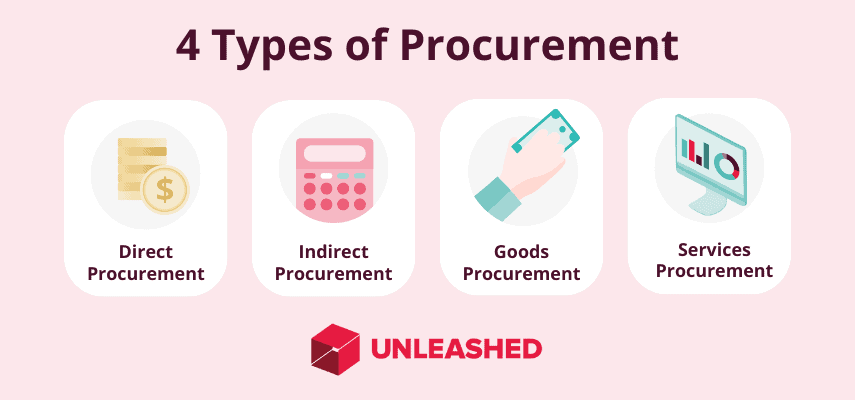
Procurement management directly impacts your bottom line, making it a critical component of running a profitable product-based business. It pertains to more than the act of purchasing goods and services: procurement management is the process that ensures any purchases from external providers meet the cost requirements, quality, quantity, and timelines of your organisation.
In this article, we look at the different stages of procurement management. We’ll also explore project procurement management and the relationship between procurement and supply chain management.
What is procurement management?
Procurement management refers to the tasks and activities undertaken to plan, negotiate, source, and then purchase the goods and services your business needs to operate. It’s a key function in any business because it directly affects costs, quality, and the efficiency of your operations.
Procurement management identifies the supply needs of your business, and then finds and assesses suppliers before selecting the best value for money. It also entails the signing of purchase contracts, managing orders and deliveries, and ensuring the appropriate levels of quality and compliance are met.
The procurement process can be simplified into three stages:
- Sourcing: The first step is to identify your business needs. Once these are established, you can start sourcing goods by requesting quotes from different suppliers, comparing pricing, and testing sample products.
- Purchasing: The purchasing stage of procurement involves negotiating payment terms with your vendors, generating orders, and receiving and inspecting deliveries. It is also important that procurement staff maintain their purchase order tracking processes during this stage.
- Payment: When it comes to payment processing, obtaining an invoice for the purchase order is crucial. Accounts payable will match the invoice to the PO number to ensure that the order and invoice are accurate. Once reconciled, the invoice can be approved and paid.
Procurement management also has a strategic impact, as it can help create a competitive advantage, foster innovation, and support business sustainability.

Why procurement management is important
When procurement is managed well, a business stays profitable and overhead costs are kept low. Without effective procurement management, you risk poor vendor relationships, delayed production cycles, or unnecessary spending.
Procurement management is particularly beneficial to smaller companies that operate with restrictive budgets and limited resources. An effective procurement management system can help you save money through the negotiation of better prices with suppliers.
Three benefits of effective procurement management:
- An effective procurement management system helps build strong supplier relationships. This results in more effective communication, faster delivery times, and better terms and conditions.
- Through automation of the procurement process, you can improve your productivity and efficiency to save both time and money, which can be redirected to a focus on business growth and augmented customer service.
- Effective procurement management aids decision-making through the provision of real-time data and insights into your procurement processes. Businesses can use this data to make more informed decisions around their purchasing strategies. It helps identify areas for improvement, and to enhance procurement workflows.
Procurement management is essential for businesses of any size. Smart procurement processes are important for your business because they help with supply chain management.
With robust procurement management, you can identify the right suppliers for your business needs and reduce your procurement costs.
What does a procurement manager do?
A procurement manager's responsibility is to find the most cost-effective deals from suppliers. Their primary goal is to determine the best ways of reducing procurement costs to provide the business with more resources to invest in its growth and resources.
Procurement managers meet with the various department heads and supervisors to identify and understand procurement needs across the entire company.
The primary responsibilities and key tasks of the procurement manager include:
- Forecasting the services and supplies necessary to operate the business.
- Reviewing requests for proposals and evaluating the feasibility of the bids submitted.
- Researching suppliers and negotiating contracts to ensure vendors can provide a steady stream of materials that fit within budget and meet company goals.
- Identifying suppliers with the required certifications, accreditation, and insurance.
- Train and support the procurement team and delegate tasks as necessary.
- Balance departmental needs within budget constraints.
- Collect and analyse data using procurement management software to ensure the company is making the best purchasing decisions.
Procurement managers should possess strong research and analytical skills with the ability to negotiate procurement contracts. These skills should be supported by proficiency in using inventory management and procurement management software.
How procurement management works: 4 key processes
The processes of procurement management have evolved. Now, they’re more dynamic than ever – built to service the needs of every business model.
Procurement processes can be divided into four categories:
- Direct procurement
- Indirect procurement
- Goods procurement
- Services procurement
Here’s a short breakdown of each type.

1. Direct procurement
Direct procurement is the straightforward purchase of the raw materials and machinery necessary for the production and sale of your company’s end product. Direct procurement has a direct impact on your business’s profitability and growth.
When engaging in direct procurement you may need to negotiate directly with the supplier for the best quality goods and services at the right price.
2. Indirect procurement
Indirect procurement involves the sourcing and acquisition of goods and services such as office supplies, marketing, and IT services – generally through a third-party provider. Indirect procurement is generally for those items that support the daily operations of the business but don’t directly affect the company’s finished goods or the business's bottom line.
If engaging in indirect procurement through a third-party provider, any price negotiations are usually with the vendor itself.
3. Goods procurement
The goods procurement process refers to acquiring physical items and may include both indirect and direct procurement of such things as raw materials, equipment maintenance, and office supplies.
Effective goods procurement relies heavily on an efficient supply chain and effective supply chain management.
4. Services procurement
Services procurement is the process of hiring third-party service providers to connect processes and employees. This can be achieved through the hiring of temporary staff, contractors, and short-term vendors; leasing software; and sourcing subscription services to provide seamless business processes and help fill any gaps between different workflows.
Types of procurement management in modern business
Procurement looks different in every industry and business model. From the simple purchasing of goods for resale to navigating complex supplier contracts, procurement management depends on a variety of processes to ensure maximum success.
Supplier management
Supplier management refers to the activities and practices undertaken to identify, qualify, and onboard your suppliers and trading partners. Businesses and procurement managers implement a supplier relationship management process to manage, transact and collaborate with their suppliers.
Long-term collaboration with suppliers can positively impact procurement performance, forecasting, flexibility, and contingency planning. Procurement teams must maintain strong supplier relationships but should always be assessing other vendors or potential new suppliers.
Contract procurement management
Contract procurement management looks after contracts and contractors related to procurement and purchasing processes. It involves the negotiation of contract terms and conditions and ensures that both parties to a contract meet their respective obligations as fully, effectively, and efficiently as possible.
Category procurement management
Category procurement management takes a systematic approach to purchasing goods and services. It’s a procurement strategy that groups similar types of expenditure by identifying potential areas for consolidation that help to create greater business value.
Category procurement approaches were initially used for project-based sourcing of goods and services. Procurement teams could make significant savings by bundling items into categories and negotiating bulk agreements with strategic supplier partners. Grouping procurement spending into categories or segments helps to increase revenue and reduce risk.
Project procurement management
Project procurement management refers to the process of acquiring the resources (through purchase, rent, or contract arrangements) needed to complete a project.
Resources can include labour, raw materials, machinery, equipment, and other supplies.
Strong supplier relationships and efficient supply chains are essential to project procurement management. These ensure the necessary resources are available to meet project deliverables, and KPIs on time and within budget.
Purchasing management
Purchase management is all about managing the processes involved when purchasing goods and services for your business. It is an integral part of business operations that identifies purchase needs, seeks approvals, sends purchase orders, and ensures deliveries are received on time.
While the terms purchasing management and procurement management are often used interchangeably, they are distinctly different.
Purchasing management refers to the practice of acquiring goods and services from external suppliers, vendors, or contractors. Procurement management, in contrast, encompasses the entire life cycle of acquiring goods and services, from planning and sourcing to contract management and disposal.

The 7 stages of procurement management
Procurement management requires careful planning, negotiation, organisation, and control to ensure the best value for money is achieved for your business.
To get this right, follow these seven key stages of procurement management.
1. Identify needs and develop a strategy
Step one identifies which goods or services – either direct or indirect – are needed for your business operations. Be specific about the quantity, quality, and delivery time required for each line item.
Practical purchasing decisions begin with a carefully considered procurement strategy that aligns with your organisation's mission statement and values.
2. Research and select suppliers
Once you’ve established your business needs you need to research and evaluate suppliers. This involves undertaking price comparisons, establishing delivery times, and determining minimum quality levels before selecting the vendors that best suit your business needs.
3. Requests for proposal
After selecting a few potential suppliers, procurement managers will send out a request for a proposal that details the specific requirements for the purchase of goods and services. The suppliers will then submit their proposals, including their prices and terms, for evaluation.
4. Evaluating proposals
When you receive all the proposals from your potential suppliers the procurement team will evaluate them to select the best option. When evaluating proposals, you should consider a range of factors such as price, quality, lead and delivery time, terms, and conditions.
5. Supplier negotiations
Once your suppliers have been selected, you will undertake negotiations with them to finalise the details of the supply arrangement. This includes agreeing on aspects of their proposal that include price, delivery date, and any other relevant factors.
6. Contract execution
After all negotiations are done, both parties will enter a contract that, once signed, legally binds both sides to the terms agreed upon. The contract will detail all aspects of the supply arrangement including expectations, price, timelines, and deliverables – along with the penalties and consequences of any breach of contract.
7. Monitoring and closeout
Monitoring your procurement contracts is a critical aspect of the procurement cycle. It allows you to measure your supplier’s performance against contract criteria to ensure that deliveries are completed on time, to the required quality standards, and at the agreed price.
Once the terms of the contract have concluded, the contract will be closed out.

Procurement management software
Procurement management software is a powerful tool that can enable your business to optimise purchasing processes and achieve better outcomes.
It helps businesses achieve their strategic goals by improving their procurement performance and results. Procurement software can save you time and money, increase quality and compliance, enhance collaboration and innovation, and give you a competitive edge in the market.
Unleashed software helps businesses better manage their procurement workflows.
With Unleashed, you can easily create purchase orders, track inventory levels, monitor supplier performance, and optimise your spending. Unleashed also integrates with popular accounting and eCommerce platforms, so you can streamline your workflows and reduce errors. Get started today with a free 14-day trial.
